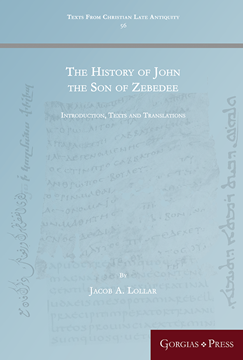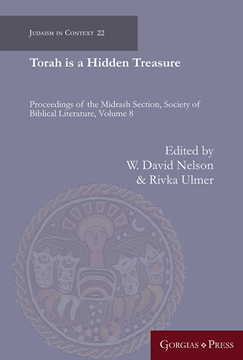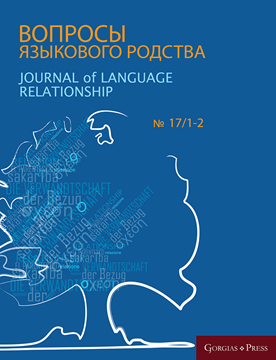The History of John the Son of Zebedee
Introduction, Texts and Translations
Series: Texts from Christian Late Antiquity 56
ISBN: 978-1-4632-4075-2
Many stories and legends about John the son of Zebedee have survived from antiquity. He was known as one of the twelve disciples of Jesus Christ, as the “Beloved Disciple” and author of the Gospel of John, and even as the recipient of the divine revelation in the Apocalypse. Later traditions, such as the Greek Acts of John, told of how John traveled to Ephesus and converted people to Christianity. John was an important figure to Catholic Christians, to Gnostic Christians, and to Manichaeans. He also found a distinct place among Syriac Christians who preserved their own story about John’s acts in Ephesus. William Wright first introduced the History of John in 1871 using two manuscript witnesses. Since then, more witnesses have been discovered, but little work has been done on this native Syriac apocryphon. The present volume brings together all of the known Syriac witnesses to the History of John with a new translation and includes, for the first time, a critical discussion of the history, provenance, and importance of this text for the study of Syriac Christianity and Christian Apocrypha more generally.
$114.95 (USD)
A Critical Edition of Kitāb al-Sawād al-aʿẓam by al-Ḥakīm al-Samarqandī
By Maher Jarrar
Series: Islamic History and Thought 27
ISBN: 978-1-4632-4077-6
The book comprises an annotated critical edition and a detailed study of Kitāb al-Sawād al-a‘ẓam by al-Ḥakīm al-Samarqandī (d. 342/953).
$138.00 (USD) $110.40 (USD)
Torah is a Hidden Treasure
Proceedings of the Midrash Section, Society of Biblical Literature
Edited by W. David Nelson & Rivka Ulmer
Series: Judaism in Context 22
ISBN: 978-1-4632-4078-3
The chapters in Torah is a Hidden Treasure pertain to authorship in Seder Eliyahu Rabba and Pirqe deRabi Eliezer, natural law and Israel’s statutes, Masorah and midrash, as well as a definition of midrash. The Hebrew Bible and midrash is researched in the interpretation of Israelite tribes, the Ten Commandments and the Covenant Code, and in Rashbam’s Bible commentary and its exegetical devices.
$128.00 (USD)
Creation and Literary Re-Creation
Ambrose’s Use of Philo in the Hexaemeral Letters
ISBN: 978-1-4632-4087-5
One of the distinctive characteristics of the writings of Ambrose of Milan is his frequent and lengthy borrowings from the works of Philo of Alexandria. He treated the 1st-century Jewish philosopher as an authoritative predecessor and made use of his works to a far greater extent than any other Church Father did. This study seeks to fill a lacuna in the current scholarship by investigating Ambrose’s use of Philo in his collection of letters, focusing on a set of three letters concerning the topic of the Genesis creation account (Ep. 29, 31, & 34 [PL#43, 44, & 45]). In all three cases, Ambrose fielded questions on the Six Days of Creation (Hexaemeron) by drawing upon Philo’s treatise De opificio mundi. Each of these letters is undeniably Philonic and yet uniquely Ambrosian. This study seeks to clarify why Ambrose found Philo to be particularly valuable in spite of his Jewishness and also to investigate how Ambrose interpreted, adapted, and ultimately re-created his source.
$146.00 (USD)
Journal of Language Relationship 17/1-2
Series: Journal of Language Relationship 17/1-2
ISBN: 978-1-4632-4089-9
The Journal of Language Relationship is an international periodical publication devoted to the issues of comparative linguistics and the history of the human language. The Journal contains articles written in English and Russian, as well as scientific reviews, discussions and reports from international linguistic conferences and seminars.
$74.00 (USD)
The Syriac Tradition of the Infancy Gospel of Thomas (paperback)
A Critical Edition and English Translation
By Tony Burke
Series: Gorgias Eastern Christian Studies 48
ISBN: 978-1-4632-4091-2
A long-awaited and essential tool for the study of one of the earliest texts of the Christian Apocrypha and an important text in Syriac literature, theology, and history.
$89.00 (USD)
Hugoye - Journal of Syriac Studies (volume 21)
2018
General Editor George Anton Kiraz
Series: Hugoye: Journal of Syriac Studies 21
ISBN: 978-1-4632-4093-6
Widely regarded as a premier journal dedicated to the study of Syriac, Hugoye: Journal of Syriac Studies was established in 1998 as a venue devoted exclusively to the discipline. An organ of Beth Mardutho, the Syriac Institute, the journal appears semi-annually and will be printed in annual editions. A peer-reviewed journal, Hugoye is a respected academic source for up-to-date information about the state of Syriac studies and for discovering what is going on in the field. Contributors include some of the most respected names in the world of Syriac today.
$75.00 (USD)
An Early Christian Reaction to Islam
Išū‘yahb III and the Muslim Arabs
Series: Gorgias Eastern Christian Studies 57
ISBN: 978-1-4632-4098-1
The year 652 marked a fundamental political change in the Middle East and the surrounding region. An important and contemporary source of the state of the Christian Church at this time is to be found in the correspondence of the patriarch of the Church of the East, Išū‘yahb III (649–659), which he wrote between 628 and 658. This books discusses Išū‘yahb’s view of and attitudes toward the Muslim Arabs.
$134.00 (USD)
The Syriac Dot (paperback)
A Short History
ISBN: 978-1-4632-4100-1
The dot is used for everything in Syriac from tense to gender, number, and pronunciation, and unsurprisingly represents one of the biggest obstacles to learning the language. Using inscriptions, early grammars, and experiments with modern scribes, Dr. Kiraz peels back the evolution of the dot layer by layer to explain each of its uses in detail and to show how it adopted the wide range of uses it has today.
$52.00 (USD)
The Palimpsest Catena of Codex Zacynthius
Series: Texts and Studies (Third Series) 22
ISBN: 978-1-4632-4105-6
This book is the first-ever edition of the complete palimpsest undertext of Codex Zacynthius (Cambridge, University Library MS Add. 10062), the earliest surviving New Testament commentary manuscript in catena format. It relies on new multispectral images produced by a research project funded by the UK Arts and Humanities Research Council in 2018.
$146.00 (USD)









